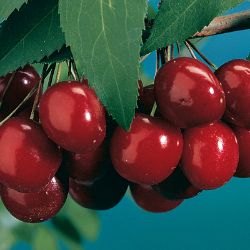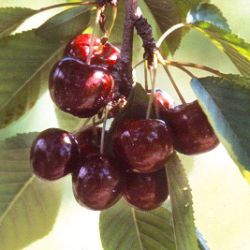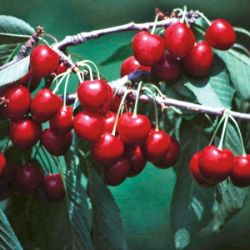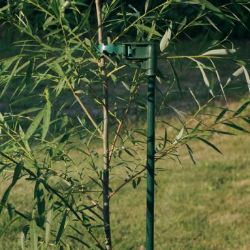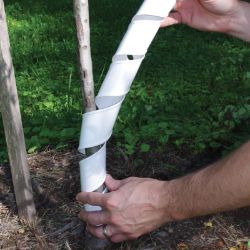Choosing a Location for Cherry Trees
The best tactic for success: Plan before you plant!
Let’s discuss location: Do you know where you want to plant your new cherry trees? Avoid many future problems by considering all facets of the planting spot, such as:
- Cross-pollination
- Sun and good soil
- The immediate surroundings
- Spacing
- Room for future plantings
NOTE: This is part 3 in a series of 11 articles. For a complete background on how to grow cherry trees, we recommend starting from the beginning.
Cross-Pollination
Stark Bro’s sells both sweet cherry trees and sour cherry trees along with some popular heirloom cherry varieties. Many of our cherry trees are self-pollinating, meaning your mature tree will bear fruit without requiring another cherry variety’s pollen; however, additional nearby (within 100 feet) cherry trees of a different variety can improve fruit-set and yield. Remember, two of the same variety will not work for cross-pollination (with the exception of seed-grown cherries) and sweet cherry trees and sour cherry trees are not recommended pollinators for one another.
Self-pollinating cherry trees work well for small spaces, because another cherry tree is not required for fruit production. Consider planting one of these popular self-pollinating cherry trees:
- Balaton® Cherry (pie/sour/tart)
- Starkrimson® Cherry (sweet)
- Stella Cherry (sweet)
- Stark® Surecrop™ Cherry (pie/sour/tart)
- North Star Cherry (pie/sour/tart)
Sun, Soil Type and Drainage
Cherry trees thrive in a location that gets full sun and has a well-drained, fertile soil. “Full sun” is defined as at least 6 to 8 hours of sun each day. Sunlight is critical to fruit production and quality, and also helps keep fungal issues from getting a foothold. Keep this in mind when choosing a location for your new cherry trees.
Good soil drainage is necessary to keep a cherry tree’s roots healthy — and healthy roots are the foundation of a healthy tree. If your native soil is composed of heavy clay that retains water after rainy weather, you should choose a different site for your cherry tree. Conversely, if your site has fast-draining sandy soil, then your cherry tree may suffer drought stress and require more frequent watering. We do not recommend planting cherry trees in either rocky or heavy, pure-clay soils. If you can’t plant elsewhere, try improving the soil prior to planting.
Even if your yard’s soil isn’t the best, take heart: cherry trees can be very adaptable and respond well to soil additives like compost or fertilizers. How you amend your soil depends heavily on your individual location, so communicating with your local county Cooperative Extension is a wise first step. In general – to help with water distribution – you can add coir like our Coco-Fiber Planting Medium to your cherry tree’s planting hole, or mix in one-third sphagnum/peat to the soil at planting time.
As an alternative to all of that digging, you can:
- Build a bottomless raised bed (at least 12 inches deep and at least 3 to 4 feet around); or
- Plant your cherry tree in a container. Plant your new tree in a 5-gallon container, to start. You can “pot-up” cherry trees into successively larger containers as the trees outgrow them.
Surroundings
Cherry trees, with their breathtaking blossoms, can also be a landscaping asset — so choose a planting site with this in mind. Imagine your new cherry tree as a full-grown tree, and think everything through:
- Are there utility wires or any other obstructions overhead?
- Are there underground cables, pipes, irrigation systems, utilities or other lines to avoid?
- Is there a sidewalk, driveway, or foundation within the range of your cherry tree’s mature spread?
- Might your cherry tree block the view of something you want to see, once it’s fully grown?
- Will neighboring trees be in the way, or block sunlight from your cherry trees as they grow?
- Even a year or two after planting, a cherry tree can be very hard to successfully transplant, so take the time to plant it in just the right place the first time!
Space Wisely
Growers often ask about the recommended planting distances for cherry trees to keep them away from patios, sewer lines, water pipes, etc. Ordinarily, patios will not be a problem because the soil beneath them is dry and compacted, and the roots will not be as encouraged to grow into this area. Conversely sewer and water lines tend to be wet, which will encourage cherry tree roots to grow around them if planted too closely.
A smart distance is somewhere beyond your cherry tree’s estimated maximum spread, which is roughly equal to the mature height of the cherry tree you choose to plant. Our recommendations are below:
- Dwarf: 8 to 14 feet
- Semi-Dwarf: 12 to 18 feet
Space for Future Plantings
If you’re new to planting cherry trees, or you’re planting them in a new location, it’s wise to start with just a few. Later on, especially after you have enjoyed the benefits of growing your own cherries firsthand, you may want to expand your orchard. Always err on the safe side and leave room for future cherry trees, other fruit trees, berry plants, and other garden plants. You’ll be glad you did.
Spacing between trees:
Dwarf Sweet, 8-10 feet
Semi-Dwarf Sweet, 15-18 feet
Standard Sweet, 18-25 feet
Dwarf Sour, 8-10 feet
Semi-Dwarf Sour, 12-15 feet
Standard Sour, 15-18 feet

















